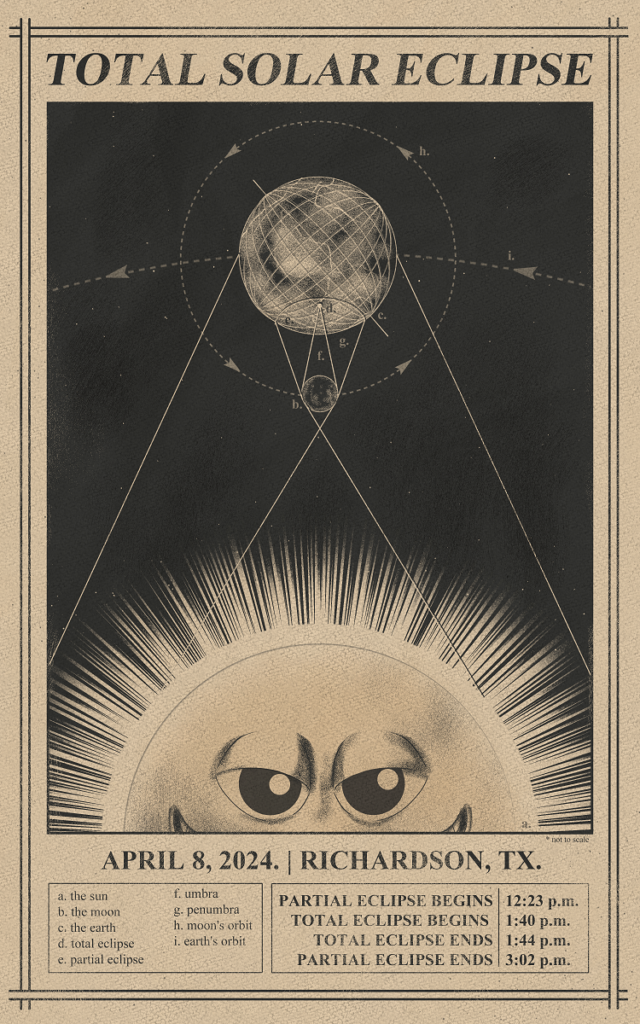Comets on campus found themselves in the direct path of a total solar eclipse on April 8 — This sighting brought thousands of spectators and experts to DFW for a phenomenon that will not return to the city until 2345.
During the morning of the celestial phenomenon, The Eclipse Planning Committee, led by UTD department head of science/mathematics education Mary Urquhart and UTD research scientist of Space Sciences Marc Haiston, held the “No Comets Left Inside” program across campus. With the help of The National Oceanic and Atmospheric Administration and the UTD Office of Research and Innovation, this program provided free merchandise, viewing glasses, telescope viewings, local music from Radio UTD and a discussion panel for the total solar eclipse. The panel included renowned UTD professor of physics and cosmologist Mustapha Ishak-Boushaki as well as Eileen Stansbery, NASA Division Chief of the Astromaterials Research and Exploration Science Division.
“Today, scientists use solar eclipses to study the sun’s outer atmosphere and [solar] corona, and we can understand a variety of things about the formation and evolution of our solar system,” Stansbery said.

For 3 minutes and 52 seconds, DFW experienced a total eclipse as the moon passed between the sun and the Earth; only the solar corona was visible, the outermost layer of the sun consisting entirely of plasma. The moon’s 167 mile wide shadow carved a path of totality that raced across North Texas at 1600 mph. At 1:41 p.m. the eclipse brought the darkness of nightfall to daytime, silencing wildlife, dropping temperatures by 2 degrees Fahrenheit and making the planet Venus visible.
Discussion for a campus event began after the partial solar eclipse in 2017, but a full planning committee wasn’t assembled until 2022, according to committee member Pamela Gossin, professor of literature and of the history of science. In December 2022 the Eclipse Planning Committee presented their plans for a campus event to the American Geophysical Union, which included helping to prepare local K-12 schools and teachers for the eclipse.
“We know that without a football stadium or without a large amount of extra parking, we couldn’t accommodate a large crowd from the general community coming to UT Dallas,” Urquhart said. “Instead, we tried to provide as much information as we could to help people in the broader DFW community area enjoy the eclipse where they were. School and teacher training was always a big part of our plan.”
The university welcomed several thousand according to UTD PD, including students, staff, local residents and travelers from across the nation; campus also hosted students from universities in Colorado, Michigan, Nevada and Utah. In a recent report, UTD said that the Dallas area would bring in a predicted more than $492,000,000 in solar-eclipse expenditures alone. Onlookers came together at the Chess Plaza, Plinth, campus roundabout, Sciences Pavilion and the Callier Center for telescope viewing of the eclipse.
Physics alumnus David Rodgers, a chemistry professor who also teaches astrology and climate courses at North Central Michigan College, was one of many who traveled from out of state to the university; Rodgers was invited to educate visitors with a Meade lx90 emc telescope at the campus roundabout.
“[The event] is fantastic, they’ve done a great job putting it together and they have a wide slice of the scientific community here,” Rodgers said.
Among the scientific community, associate professor of physics Fabiano Rodrigues and his student research team deployed signal sensors on the ground across campus with support from the Eclipse Planning Committee, which monitored interactions between the upper atmosphere and the eclipse during the event.
To ensure all students and faculty could view the total eclipse at 1:41 p.m., all classes and non-essential jobs were closed on campus between 1 p.m. and 2 p.m.
“I hope that our whole Comet community was able to experience this profound celestial event,” Urquhart said. “This was an incredible experience to really bring us all together as a Comet community, because wherever people were, we were all experiencing it at the same time.”
Leave a Reply